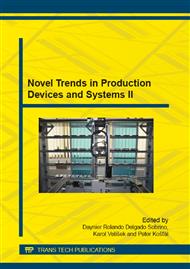[1]
G.M. Krolczyk, P. Nieslony, S. Legutko, Determination of tool life and research wear during duplex stainless steel turning, Archives of Civil and Mechanical Engineering. (2014) http: /dx. doi. org/10. 1016/j. acme. 2014. 05. 001.
DOI: 10.1016/j.acme.2014.05.001
Google Scholar
[2]
D. Jianxin, Z. Jiantou, Z. Hui, Y. Pei, Wear mechanisms of cemented carbide tools in dry cutting of precipitation hardening semi-austenitic stainless steels, Wear. 270 (2011) 520–527.
DOI: 10.1016/j.wear.2011.01.006
Google Scholar
[3]
S. Hloch, J. Valicek, D. Kozak, Preliminary results of experimental cutting of porcine bones by abrasive waterjet, Tehnicki Vjesnik - Technical Gazette. 18, 3 (2011) 467–470.
Google Scholar
[4]
J. B. Krolczyk, An attempt to predict quality changes in a ten-component granular system, Tehnicki Vjesnik - Technical Gazette. 21, 2 (2014) 255–261.
Google Scholar
[5]
V.T.G. Naves, M.B. Da Silva, F.J. Da Silva, Evaluation of the effect of application of cutting fluid at high pressure on tool wear during turning operation of AISI 316 austenitic stainless steel, Wear. 302 (2013) 1201–1208.
DOI: 10.1016/j.wear.2013.03.016
Google Scholar
[6]
F. Pusavec, P. Krajnik, J. Kopac, Transitioning to sustainable production – Part I: application on machining technologies, Journal of Cleaner Production. 18 (2010) 174–184.
DOI: 10.1016/j.jclepro.2009.08.010
Google Scholar
[7]
M. Wieczorowski, Spiral sampling as a fast way of data acquisition in surface topography, International Journal of Machine Tools and Manufacture. 41 (2001) 2017–(2022).
DOI: 10.1016/s0890-6955(01)00066-9
Google Scholar
[8]
G. Krolczyk, P. Raos, S. Legutko, Experimental analysis of surface roughness and surface texture of machined and fused deposition modelled parts, Tehnicki Vjesnik - Technical Gazette. 21, 1 (2014), 217–221.
Google Scholar
[9]
P. Hreha, A. Radvanska, J. Carach, D. Lehocka, K. Monkova, G. Krolczyk, A. Ruggiero, I. Samardzic, D. Kozak, S. Hloch, Monitoring of focusing tube wear during Abrasive WaterJet (AWJ) cutting of AISI 309, Metalurgija. 53 4 (2014) 533-536.
Google Scholar
[10]
T. G. Mathia, P. Pawlus, M. Wieczorowski, Recent trends in surface metrology, Wear. 271, 3–4 (2011) 494–508.
DOI: 10.1016/j.wear.2010.06.001
Google Scholar
[11]
G. Krolczyk, P. Nieslony, S. Legutko, Microhardness and Surface Integrity in Turning Process of Duplex Stainless Steel (DSS) for Different Cutting Conditions, Journal of Materials Engineering and Performance. 23, 3 (2014) 859–866.
DOI: 10.1007/s11665-013-0832-4
Google Scholar
[12]
G. Krolczyk, P. Nieslony, S. Legutko, A. Stoic, Microhardness changes gradient of the duplex stainless steel (DSS) surface layer after dry turning, Metalurgija. 53, 4 (2014) 529-532.
DOI: 10.1007/s11665-013-0832-4
Google Scholar


